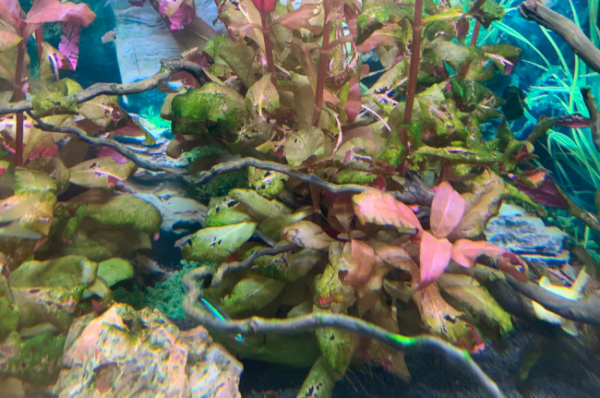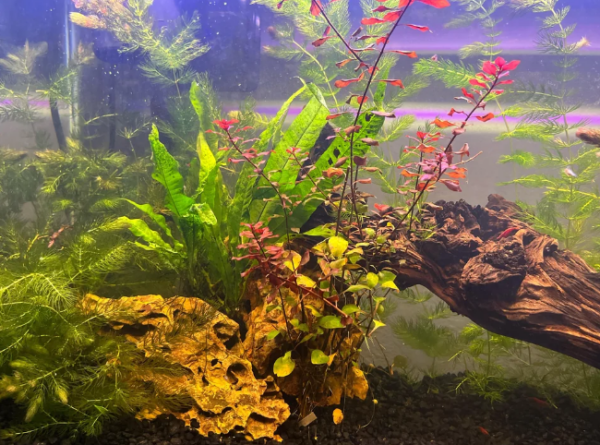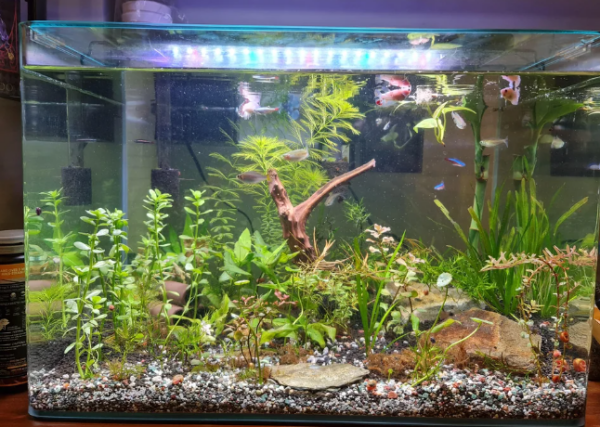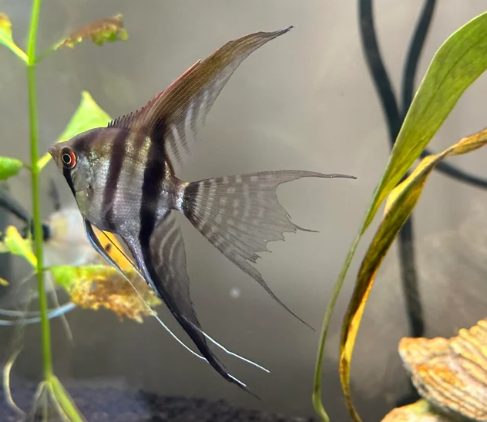Chemical changes in artificial waters are more rapid than in the atmosphere, where it takes substantial changes in the air quality for significant shifts to occur. Despite their ability to adapt to most environments, Aquatic plants are susceptible to chemical, mechanical, and nutritional influences.

Holes or rots in aquarium plant leaves are typical in matured planted tanks. Plants occasionally kill off older leaves by extracting all the nutrients from them to grow new foliage. The unnatural frequency of yellowing leaves and the presence of holes, however, are cause for concern.
In this article, we’ll go through all the major reasons behind the appearance of holes in your aquarium plants and discuss mitigation strategies for them.
Table of Contents
Nutrient Deficiency
The primary and frequently the most common reason behind decay and holes appearing in plants is nutrient deficiency. Lack of proper nutrients in water and fertilizers restrains the plant from delivering essential elements to the leaves. In trying to nourish the newer leaves with the available nutrients, the older leaves are deserted—causing holes in them.
Nutrient deficiencies that mainly cause holes in aquarium plants are:
Potassium Deficiency
Potassium supports growth and helps resist disease in plants. Potassium also acts as a catalyst for enzyme activation and the opening and closing of stomata.
Stunted growth, weakened root system, and pinholes in leaves are potent potassium deficiency symptoms appearing in aquatic plants. The holes would often be bordered with yellow or brown. A prolonged lack of potassium often causes chlorosis and necrosis in aquarium plants and may prove to be fatal.
Potassium supplements are by far the most effective method to mitigate the issue. Eliminating the cause of deficiency (for example: algae or absence of enriched soil) before dosing the potassium-rich liquid as per the instructions should be sufficient to revive the poked plants.
Best potassium supplement for aquarium plants: Seachem Flourish Potassium
Magnesium Deficiency
Magnesium is a central component of chlorophyll—the substance responsible for the green color of leaves, that helps the plants capture sunlight for photosynthesis. Magnesium also acts as a cofactor for multiple enzymes involved in cell growth and carbohydrate metabolism.
As it is also involved in the transportation of other nutrients, magnesium deficiency mostly affects older leaves than younger ones. The most common symptom of which is chlorosis—yellowing or bleaching of the leaves, paired with the occasional appearance of holes. In some cases, magnesium deficiency also causes curled leaves.
Magnesium deficiency is usually caused due to low water hardness and can be mitigated by water changes. Most commercial plant fertilizers (aquarium fertilizers) also contain generous amounts of magnesium to support the nutrient balance.
Calcium Deficiency
Calcium is critical to building the physical strength of aquatic plants. Calcium is an essential component of plant cell walls and provides rigidity and stability to the tissues. Regulating enzyme activity and signaling pathways for smoother membrane function. Calcium also involves itself in cell division and elongation—ensuring overall plant growth and shoot strength.
Holes and necrosis in new leaves, stunted growth, and curled leaf tips are indicative of calcium deficiency. While older leaves remain unaffected initially, they also show discoloration and curling with prolonged calcium deficiency. Overall, weak stems, poor growth, and a weakened immune system are caused by a lack of calcium.
Soft water lacks calcium. Hence, desperate and repeated use of RO/DI water depletes calcium in the water. A high level of competing minerals, including magnesium or potassium, may also hinder calcium uptake. Moreover, inert substances also lack sufficient calcium to replenish the requirements. Using moderately hard water and fertilizers should resolve the issue.
Phosphorus Deficiency
Phosphorus is a key component of ATP, the energy currency of cells. Without the adequate amount of the same, plants lack the energy to perform essential biological processes, including growth, photosynthesis, and cell repair. Phosphorus is even involved in the creation of DNA and RNA. It also contributes to the production of phospholipids, vital components of cell membranes.
Phosphorous deficiency hinders cell division and can limit growth potential. Severe deficiency often causes leaves to distort, twist, and deform—breaking and dying. The leaves lose their characteristic green and turn into soggy yellow or brown. In most cases, the leaves also become brittle and develop elongated holes.
Limit using phosphorus-absorbing foams and monitor your water quality closely, particularly phosphate levels. Supplementing the water with appropriate fertilizers should also address the deficiency. Furthermore, certain laterite-based substrates naturally release phosphorus over time. However, make sure that you aren’t overdosing your tank with phosphorus and promoting algae growth in the tank.
Best phosphate test kit: API Phosphate Test Kit
Best phosphate fertilizer: Seachem Flourish Phosphorus
Sulfur Deficiency
Sulfur is an essential component for chlorophyll production. Without a sufficient supply of sulfur in either the water or the soil, your aquatic plants may develop conditions similar to magnesium deficiency.
Sulfur is also quite involved in the process of amino acid synthesis, which ensures the proper structure of proteins. Amino acids are pretty essential for several plant functions, such as enzyme activity and defense mechanisms.
This macronutrient also helps plants grow resistance against environmental stresses and fluctuations in parameters.
The most common indication of sulfur deficiency is the yellowing of leaves and the occurrence of holes. Stunted growth, interveinal chlorosis, and weaker stems are also denotative of sulfur deficiency.
Having fish in the aquarium helps replenish the sulfur to a great extent. Driftwood and fertilizers can also be quite beneficial in this regard. However, simple water changes with de-chlorinated water (not RO/DI) can replenish the sulfur content without the risk of over-fertilization.
Nitrogen Deficiency
Similar to magnesium, nitrogen is a key component of chlorophyll. Without enough nitrogen in the water, chlorophyll production declines and impacts the biological functions of both terrestrial and aquatic plants. Aside from playing a role in nutrient uptake and utilization, nitrogen also contributes to protein synthesis and enzyme production.
Nitrogen deficiency limits chlorophyll production and causes the leaves to turn yellow. It majorly impacts the older leaves and gradually extends to younger foliage—starting typically from the leaf tips. Unnatural leaf loss, translucent leaves, and stunted growth are also evidence of nitrogen deficiency.
In a balanced ecosystem, nitrogen is delivered by the organic matter released by the fish and rotting leaves. However, filtration systems in aquariums often break down the ammonia and nitrogen way before they can be used by the plants, for the residual components to be eliminated through water changes.
Testing water parameters, especially nitrate, and administering fertilizers rich with nitrogen are key to salvaging the issue. Although fish are a good source of nitrogen, avoid overstocking to prevent ammonia poisoning.
Pest Infestation

Aquatic pests often nibble on plants, leave glaring holes, and strip them off of nutrition. Pests often arrive in the tank by hitchhiking and usually stay effectively hidden. Most aquarium pests reproduce a lot and are pretty challenging to eliminate without significant effort, often to the extent of restarting the tank.
A few common aquarium pests that eat plants are:
Snails
Mostly kept as supplementary creatures for nutrient cycling and to control algae, given optimum temperature and food, snails can reproduce a lot. Smaller snails in particular are notorious leaf-eaters, and their population can explode within a few weeks of introduction. Wild snails also often hitchhike from other tanks with new plants and decorations.
Snail removal usually involves:
- Manual Removal
Removing snails is relatively easy, especially for larger species. Simply pluck them off the plants and substrate by hand. Be also sure to remove the jelly-like egg clusters floating or stuck on surfaces.
- Snail Traps
DIY traps, baited by lettuce or cucumber, can be great for eliminating snails in clusters. You may also purchase them online.
- Predatory Fish
Predatory fish, such as clown loaches and pea puffers, can be effective in controlling the snail population. However, they may also be incompatible with existing fish and plants. Do your research before introducing them to the tank.
Also Read: How To Check If A Snail Dead Or Sleeping: Complete Guide
Copepods
Copepods are detritivores and help clean up decaying organic matter. While they aren’t harmful to fish or plants, they can be considered a “great snack” for other pests like snails. They may also carry diseases and parasites that may infect your plants.
- Cleaning the tanks often eliminates their food source and helps reduce their population.
- They’re attracted to light and may be gathered by shining a flashlight to be siphoned out.
- Don’t overfeed your tank inhabitants, as copepods take advantage of the uneaten food.
- Small fish like rasboras, tetras, and guppies love to hunt copepods.
Planaria, limpets, and many other pests may also directly and indirectly harm your plants. Consider removing them from the tank if they’ve exploded in population.
Inadequate Lighting

Plants require a massive amount of light to convert oxygen and water into carbohydrates through photosynthesis. Inadequate lighting causes malnutrition and often presents issues like chlorosis, necrosis, and leaf holes.
In this section, we’ll discuss a few lighting issues that may be resulting in the deformities in your plants.
Improper Day/Night Lighting
Most plants produce food in the day and burn stored energy to grow around the clock. Contrary to popular belief, night lighting is essential for the growth of plants and to replenish natural CO2 in the tank.
Lack of either daylight or nightlight can prove to be detrimental to the well-being of your aquarium plants. They may grow to develop holes in the leaves and weak stems and perform premature leaf replacement.
In artificial waters, aquarists employ lighting systems with automatic timers that control the day/night settings. Usually, 8-10 hours of daylight is adequate for most aquatic plants. Offering not enough night light would fail to replenish the CO2 requirements during the day.
Lack of Full Spectrum Lighting
Full spectrum lighting settings maximize the growth rate of the plants. However, the absence of the same can cause several health issues, including a weakened immune system and necrosis in plants—causing leaves to rot and turn yellow.
Full spectrum lights generally include a varying number of white, red, green, blue, and yellow lights. Many premium products, however, also include other colors to imitate both the ultraviolet and infrared spectrum.
You may consider a hygger 14W LED light for your planted aquarium.
Inadequate Penetration
A majority of cheap aquarium lights can’t penetrate the water column and reach the bottom despite having a great number of lights. This increases competition in the tank, and the younger plants fall prey to the hostility.
Inadequate penetration can cause the lower plants to starve and fall prey to malnutrition. The larger plants may also strip nutrition away from the lower leaves to nourish the foliage that is being subjected to adequate lighting.
When buying aquarium lighting, keep an eye out for something similar to: “80 PAR @ 12in Depth” or “lumens.” These are the units for light intensity.
Fish Damage

Numerous fish species love to munch on leaves. While herbivore fish are often the main culprit, the habit of plant obliteration rarely follows their diet preference. Irrespective of their food choice, fishes may occasionally play with the leaves and uproot the plants.
While the list isn’t exhaustive, some typical plant destroyer species include:
- Goldfish
- Siamese Algae Eater
- Plecostomus (Plecos)
- Silver Dollar
- Tinfoil Barb
- African Cichlids
- Rosy Barbs
- Green Severum
Unless you want to avoid keeping these species in the tank, there is no way to mitigate the issues. While you may use artificial plants, that nullifies the point of this article. However, you can do your research before introducing new plants or new fish to your tank to avoid or minimize the issue.
Water Quality Issues
Water quality issues may also contribute to the appearance of holes in your plant leaves.
pH Imbalance
Plants are usually more resilient to water parameter changes than fish and invertebrates. However, extreme pH deviations can cause stunted root and stem growth, turn leaves brown and yellow and restrict specific nutrient uptake. Severe pH imbalance cases may also be fatal to aquarium plants.
CO2 Deficiency
An overstocked tank, not enough night light, and a lack of supplementation cause CO2 deficiency in the tank. It diminishes plant growth and often leads younger plants to death due to competition and stress.
High Ammonia Levels
While dissolved ammonia is a great source of nitrogen for plants, an excessive amount of it may prove to be toxic and promote algae growth. Algae bloom strips the plants away from essential nutrients. An exorbitant level of ammonia also indicates larger issues and demands immediate attention.
Poor Water Circulation
Aquatic plants mostly rely on the dissolved nutrients. Poor water circulation diminishes the process and may leave your plants with deficiencies despite having enough nutrients in the water. Oxygen and CO2 also need to be supplied to them through water circulation to perform the metabolic processes.
Mitigation Strategies
Monitoring water parameters and taking necessary actions to bring them to the optimal levels is the key mitigation strategy. Consider allowing water circulation throughout every corner of the tank and administering fertilizers sparingly.
Mechanical Damage
Although rare, mechanical damages may also occur in planted tanks. Some of them include:
Decorations
Sharp decorations may damage the leaves of your plants. If you have fish that are playful, they may also push the smaller decorations around and harm the juvenile plants.
Water Currents
While water circulation is necessary for plants to survive, strong water currents may harm the plants or even uproot them. Consider a casual flow through the plants for the best results.
Algae Scrubbing
Commercial algae scrubbers can harm the leaves if not careful enough. Alternatively, you may introduce algae-eating fish.
FAQs
There are several reasons why your plants are getting holes. Nutrient deficiency, pest infestation, and irregular water parameters are considered the primary reason behind plant issues.
Aquarium plants dissolve due to nutrient deficiencies. A lack of potassium, calcium, nitrogen, and magnesium can decay your plants.
Yellowing or wilting of leaves and stunted growth are the signs of low CO2 in planted aquariums. CO2 supplementation and increasing night light are effective mitigation strategies.
The Bottom Line
We’ve compiled a list of reasons behind the appearance of holes in your aquarium plants. Hopefully, you’ll now be able to diagnose the issue and embrace mitigation strategies according to it.


